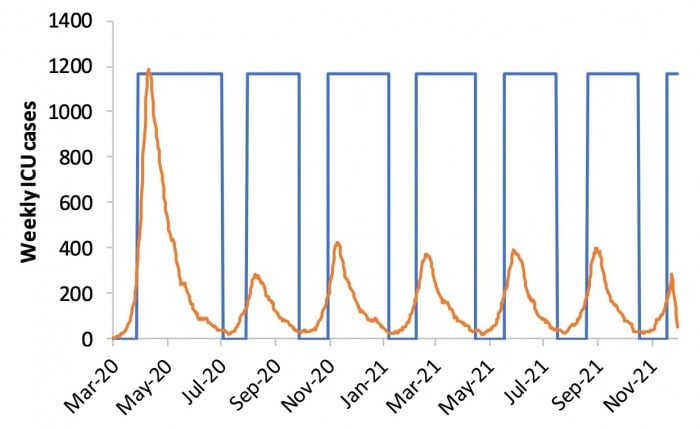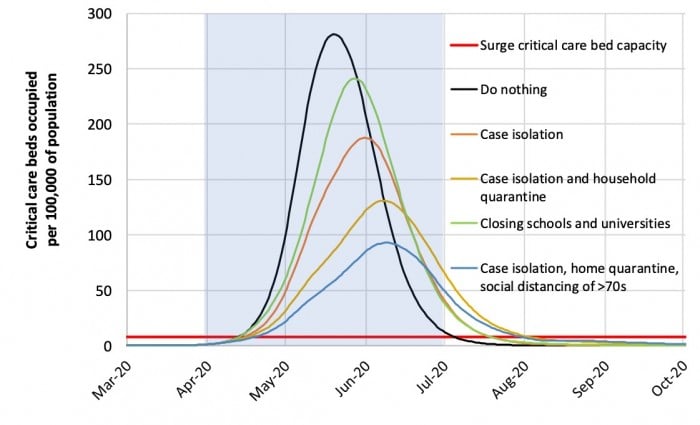________
Source: Technology Review
Social distancing is here to stay for much more than a few weeks. It will upend our way of life, in some ways forever.
by Gideon Lichfield | March 17, 2020
To stop coronavirus we will need to radically change almost everything we do: how we work, exercise, socialize, shop, manage our health, educate our kids, take care of family members.
We all want things to go back to normal quickly. But what most of us have probably not yet realized—yet will soon—is that things won't go back to normal after a few weeks, or even a few months. Some things never will.
It's now widely agreed (even by Britain, finally) that every country needs to "flatten the curve": impose social distancing to slow the spread of the virus so that the number of people sick at once doesn’t cause the health-care system to collapse, as it is threatening to do in Italy right now. That means the pandemic needs to last, at a low level, until either enough people have had Covid-19 to leave most immune (assuming immunity lasts for years, which we don't know) or there's a vaccine.
How long would that take, and how draconian do social restrictions need to be? Yesterday President Donald Trump, announcing new guidelines such as a 10-person limit on gatherings, said that "with several weeks of focused action, we can turn the corner and turn it quickly." In China, six weeks of lockdown are beginning to ease now that new cases have fallen to a trickle.
But it won't end there. As long as someone in the world has the virus, breakouts can and will keep recurring without stringent controls to contain them. In a report yesterday (pdf), researchers at Imperial College London proposed a way of doing this: impose more extreme social distancing measures every time admissions to intensive care units (ICUs) start to spike, and relax them each time admissions fall. Here's how that looks in a graph.
The orange line is ICU admissions. Each time they rise above a threshold—say, 100 per week—the country would close all schools and most universities and adopt social distancing. When they drop below 50, those measures would be lifted, but people with symptoms or whose family members have symptoms would still be confined at home.
What counts as "social distancing"? The researchers define it as "All households reduce contact outside household, school or workplace by 75%." That doesn't mean you get to go out with your friends once a week instead of four times. It means everyone does everything they can to minimize social contact, and overall, the number of contacts falls by 75%.
Under this model, the researchers conclude, social distancing and school closures would need to be in force some two-thirds of the time—roughly two months on and one month off—until a vaccine is available, which will take at least 18 months (if it works at all). They note that the results are "qualitatively similar for the US."
Eighteen months!? Surely there must be other solutions. Why not just build more ICUs and treat more people at once, for example?
Well, in the researchers' model, that didn't solve the problem. Without social distancing of the whole population, they found, even the best mitigation strategy—which means isolation or quarantine of the sick, the old, and those who have been exposed, plus school closures—would still lead to a surge of critically ill people eight times bigger than the US or UK system can cope with. (That's the lowest, blue curve in the graph below; the flat red line is the current number of ICU beds.) Even if you set factories to churn out beds and ventilators and all the other facilities and supplies, you'd still need far more nurses and doctors to take care of everyone.
How about imposing restrictions for just one batch of five months or so? No good—once measures are lifted, the pandemic breaks out all over again, only this time it's in winter, the worst time for overstretched health-care systems.
Please go to Technology Review to read more Covid propaganda.
Source: Technology Review
Social distancing is here to stay for much more than a few weeks. It will upend our way of life, in some ways forever.
by Gideon Lichfield | March 17, 2020
To stop coronavirus we will need to radically change almost everything we do: how we work, exercise, socialize, shop, manage our health, educate our kids, take care of family members.
We all want things to go back to normal quickly. But what most of us have probably not yet realized—yet will soon—is that things won't go back to normal after a few weeks, or even a few months. Some things never will.
It's now widely agreed (even by Britain, finally) that every country needs to "flatten the curve": impose social distancing to slow the spread of the virus so that the number of people sick at once doesn’t cause the health-care system to collapse, as it is threatening to do in Italy right now. That means the pandemic needs to last, at a low level, until either enough people have had Covid-19 to leave most immune (assuming immunity lasts for years, which we don't know) or there's a vaccine.
How long would that take, and how draconian do social restrictions need to be? Yesterday President Donald Trump, announcing new guidelines such as a 10-person limit on gatherings, said that "with several weeks of focused action, we can turn the corner and turn it quickly." In China, six weeks of lockdown are beginning to ease now that new cases have fallen to a trickle.
But it won't end there. As long as someone in the world has the virus, breakouts can and will keep recurring without stringent controls to contain them. In a report yesterday (pdf), researchers at Imperial College London proposed a way of doing this: impose more extreme social distancing measures every time admissions to intensive care units (ICUs) start to spike, and relax them each time admissions fall. Here's how that looks in a graph.
A graph of weekly ICU cases over time.
Periodic bouts of social distancing keep the pandemic in check.
Imperial College Covid-19 Response Team.
The orange line is ICU admissions. Each time they rise above a threshold—say, 100 per week—the country would close all schools and most universities and adopt social distancing. When they drop below 50, those measures would be lifted, but people with symptoms or whose family members have symptoms would still be confined at home.
What counts as "social distancing"? The researchers define it as "All households reduce contact outside household, school or workplace by 75%." That doesn't mean you get to go out with your friends once a week instead of four times. It means everyone does everything they can to minimize social contact, and overall, the number of contacts falls by 75%.
Under this model, the researchers conclude, social distancing and school closures would need to be in force some two-thirds of the time—roughly two months on and one month off—until a vaccine is available, which will take at least 18 months (if it works at all). They note that the results are "qualitatively similar for the US."
Eighteen months!? Surely there must be other solutions. Why not just build more ICUs and treat more people at once, for example?
Well, in the researchers' model, that didn't solve the problem. Without social distancing of the whole population, they found, even the best mitigation strategy—which means isolation or quarantine of the sick, the old, and those who have been exposed, plus school closures—would still lead to a surge of critically ill people eight times bigger than the US or UK system can cope with. (That's the lowest, blue curve in the graph below; the flat red line is the current number of ICU beds.) Even if you set factories to churn out beds and ventilators and all the other facilities and supplies, you'd still need far more nurses and doctors to take care of everyone.
In all scenarios without widespread social distancing, the number of Covid cases overwhelms the healthcare system.
Imperial College Covid-19 Response Team
How about imposing restrictions for just one batch of five months or so? No good—once measures are lifted, the pandemic breaks out all over again, only this time it's in winter, the worst time for overstretched health-care systems.
Please go to Technology Review to read more Covid propaganda.
________
Opposition is rapidly growing worldwide as more and more people are realizing we are being turned into machines...
This is a war on humanity:
Vaccine Wars – Pharma Lobby Wants To Punish Countries Pushing For Low Cost Vaccines
Vaccine Wars – Pharma Lobby Wants To Punish Countries Pushing For Low Cost Vaccines
Thanks, Van Morrison...
HONORED TO BE AN ESSENTIAL PUBLIC SERVICE PROVIDER.



No comments:
Post a Comment
Note: Only a member of this blog may post a comment.